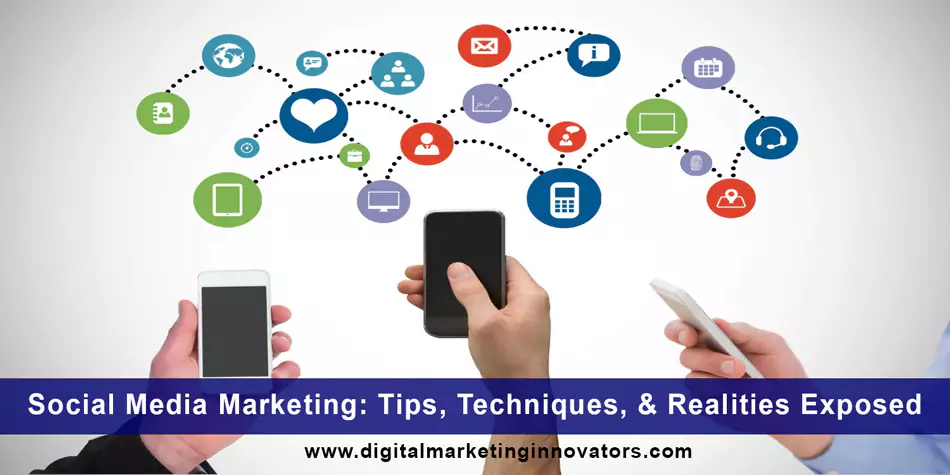Contents
- 1 Why Social Media Marketing is Essential?
- 2 Best Tips for Effective Social Media Marketing
- 3 1. Know Your Audience Like a Friend
- 4 2. Think of your content as a love
- 5 3. Engage, Don’t Just Post
- 6 4. The Power of Authentic Storytelling
- 7 5. Embrace Visual Content
- 8 6. Consistency: The Key to Trust
- 9 7. Utilize Analytics for Growth
- 10 Techniques to Amplify Your Social Media Strategy
- 11 Leverage User-Generated Content
- 12 Collaborate with Influencers Who Resonate with Your Brand
- 13 Timing is Everything: Post at the Right Moments
- 14 Use Hashtags Wisely
- 15 Run Targeted Social Media Ads
- 16 Benefits of Social Media Marketing
- 17 Navigating the Challenges of Social Media Marketing
- 18 Conclusion of Social Media Marketing
- 19 FAQs About Social Media Marketing
Social media marketing isn’t just a strategy—it’s the heartbeat of your brand in the digital age. It’s where emotions run high, connections are forged, and brands become more than just logos. They become stories, experiences, and parts of people’s lives. In a world where attention spans are fleeting, social media is where your brand can truly shine, making an emotional impact that resonates with your audience on a personal level.
Why Social Media Marketing is Essential?
At its core, social media management and marketing is about building relationships. It’s not just about promoting products or services; it’s about engaging with real people who have real emotions, needs, and desires. When done right, social media marketing transforms brands into communities, turning customers into advocates who believe in what you do.
But it’s not just about the numbers or the reach—it’s about the human connection. People want to feel understood, valued, and heard. They crave authenticity in a world full of noise. Social media marketing offers a unique opportunity to connect with your audience on a deeper level, to show them that behind every post, every tweet, every story, there’s a person who cares.
Best Tips for Effective Social Media Marketing
1. Know Your Audience Like a Friend
Imagine sitting down with a close friend over a cup of coffee, listening to them share their dreams, frustrations, and what truly matters to them. That’s how you should approach understanding your audience. It’s not just about knowing their age, location, or income level—it’s about diving deep into their world. Picture a small business owner, juggling responsibilities while trying to find ways to grow their brand.
They’re overwhelmed, maybe even a bit scared, but they’re also hopeful, passionate, and determined. When you understand this, you can craft messages that not only address their needs but touch their hearts. For instance, sharing a story about overcoming adversity or a motivational post about never giving up might resonate deeply with them, making them feel like you’re speaking directly to their soul.
2. Think of your content as a love
Letter to your audience, filled with sincerity and emotion. It’s not just about throwing up a quick post because it’s “that time of day.” It’s about creating something meaningful, something that will leave a lasting impression. Imagine posting a heartfelt video about a customer who used your product to change their life—a mother who started a small business from her kitchen table and now supports her family because of your support. Or a simple yet powerful image of a sunrise with a caption about new beginnings, sparking feelings of hope and possibility. Your content should be more than just words and pictures; it should be an experience, a connection that leaves your audience feeling inspired, understood, and valued.

3. Engage, Don’t Just Post
Social media is like a lively gathering, filled with conversations, laughter, and meaningful exchanges. Don’t just be a spectator—jump into the mix! When someone takes the time to comment on your post, they’re opening a door to a conversation, so step through it. Imagine a follower sharing their excitement about a new product you’ve launched. Instead of just liking their comment, reply with genuine enthusiasm: “We’re thrilled that you’re excited! What feature are you most looking forward to?”
This small act of engagement turns a simple comment into a dialogue, making your followers feel seen and appreciated. Or consider hosting a live Q&A where you answer questions directly from your audience, giving them the chance to connect with you in real-time. Engagement isn’t just about building a following; it’s about building relationships, creating a community where every voice matters.
4. The Power of Authentic Storytelling
Imagine sitting around a campfire, where stories are shared, hearts are opened, and connections are made. That’s the kind of bond authentic storytelling can create between your brand and your audience. People don’t just want to know what you sell—they want to know *why* you do it. Share the story of how your brand came to life. Maybe it all started with a dream and a tiny garage, where late nights and early mornings were spent chasing that dream, facing obstacles, and celebrating small victories. Tell the tale of your first big challenge and how you overcame it, not just with strategy but with sheer determination.
Perhaps your brand’s journey was inspired by a personal experience—a moment of need, a spark of inspiration, or a desire to make the world a better place. For example, a skincare company might share the founder’s struggle with finding natural, effective products for sensitive skin, leading them to create their own solutions. These authentic stories don’t just sell a product; they build a narrative that your audience can connect with on a personal level, turning your brand into something more than just a name—it becomes a story they want to be a part of.
5. Embrace Visual Content
In a world where attention spans are shrinking, visual content is your golden ticket to capturing and holding your audience’s gaze. Think of that powerful image that stopped you mid-scroll—a vibrant sunset, a smiling child, or a sleek product shot that just oozes quality. Visuals are more than just eye candy; they’re the language of social media. Take, for example, a fitness brand that shares a before-and-after photo of a customer’s transformation, paired with an uplifting story of their journey.
This isn’t just a picture; it’s a testament to the impact your brand can have. Or consider the power of a short, emotional video that takes viewers behind the scenes of your creative process, showing the passion and care that goes into every product. Visuals like these don’t just attract attention; they tell a story, evoke emotions, and drive engagement. Don’t hesitate to play with different formats—try an Instagram Story to share a day in the life of your brand, or a TikTok video that showcases your product in a fun, creative way. Each platform offers a unique canvas, so paint your brand’s picture with the vibrant colors of high-quality visuals.
6. Consistency: The Key to Trust
Imagine walking into your favorite café every morning, knowing exactly what to expect—the warm smile of the barista, the comforting aroma of freshly brewed coffee, and the cozy corner where you always sit. That sense of consistency is what builds trust, and the same principle applies to your social media presence. Your audience should feel that same sense of familiarity every time they interact with your brand. Whether it’s the tone of your posts, the visual style of your images, or the values you convey, consistency creates a dependable brand experience. Take, for instance, a fashion brand that consistently shares posts with a chic, minimalist aesthetic and empowering messages about body positivity.
Over time, this consistent approach helps the brand stand out and builds a loyal following who knows what to expect and loves the brand for it. To maintain this consistency, create a content calendar that not only schedules your posts but also ensures that your brand’s voice, tone, and message are harmonized across all platforms. Consistency isn’t just about being reliable; it’s about being recognizable, memorable, and trustworthy.
7. Utilize Analytics for Growth
While creativity and emotion fuel your social media efforts, it’s the data that will steer you in the right direction. Think of analytics as the compass that guides your brand through the ever-changing landscape of social media. It’s one thing to feel like your content is resonating, but it’s another to *know* it. Use analytics tools to dive deep into the metrics—track the likes, shares, comments, and views, but also pay attention to deeper insights like audience demographics, peak engagement times, and the type of content that performs best.
For instance, if you notice that your audience engages more with video content than with static images, it’s a clear signal to focus more on video in your strategy. Or, if you discover that your posts receive the most interaction on weekends, you might shift your content calendar to capitalize on that trend. Data-driven decisions help you refine your strategy, ensuring that your efforts aren’t just creative but also effective. By consistently analyzing and adjusting your approach, you can optimize your campaigns, ensuring that your brand grows and evolves in tune with your audience’s needs and behaviors.
Techniques to Amplify Your Social Media Strategy
Leverage User-Generated Content
Imagine the excitement a customer feels when they see their own photo or video featured on a brand’s social media page. It’s not just a moment of recognition—it’s a shared experience that creates a bond between the customer and the brand. User-generated content (UGC) is like word-of-mouth marketing supercharged by the digital age. For instance, a fitness brand might encourage customers to share their workout routines using a specific hashtag.

When you repost these photos and videos on your own channels, it’s a powerful endorsement. It shows that real people are using and loving your products, which is far more convincing than any polished ad. For example, if a customer posts a video of themselves achieving a personal best while wearing your brand’s athletic gear, sharing that content not only celebrates their achievement but also subtly reinforces the quality and reliability of your products. UGC doesn’t just build credibility; it also creates a vibrant community of loyal customers who feel like they’re part of something bigger.
Collaborate with Influencers Who Resonate with Your Brand
Imagine the difference between a forced endorsement and a genuine recommendation from someone you trust. That’s the power of choosing the right influencer for your brand. Influencer marketing isn’t just about finding someone with a huge following—it’s about finding someone whose values align with your brand’s mission and who has a genuine connection with their audience. Take, for example, a sustainable fashion brand partnering with an influencer who is passionate about eco-friendly living.
This influencer might share how your brand’s products fit seamlessly into their lifestyle, not just because they’re paid to do so, but because they truly believe in your mission. This authenticity shines through in their content, making their followers more likely to trust and act on their recommendations. When an influencer who resonates with your brand tells your story, it feels like a trusted friend sharing a great find, rather than a hard sell, and this authenticity can lead to deeper, more meaningful connections with new audiences.
Timing is Everything: Post at the Right Moments
Imagine your carefully crafted post going live just when your audience is most active, resulting in a flood of likes, comments, and shares. That’s the magic of posting at the right time. Social media is a fast-paced environment, and timing can be the difference between your content being seen and it getting lost in the shuffle.
For instance, if you’re a café that knows your audience tends to browse social media during their morning commute, scheduling a post featuring your latest coffee blend at 7:30 AM can catch them right when they’re thinking about their first cup of the day. Use analytics to uncover these golden windows on each platform, and tailor your posting schedule to match your audience’s habits. Whether it’s an evening post on Facebook when your followers are winding down after work, or a lunchtime tweet, timing your content strategically ensures that it reaches the maximum number of people when they’re most likely to engage with it.
Hashtags are like the signposts that guide people to your content in the vast landscape of social media. But just like signposts, they need to be placed carefully to be effective. It’s not about stuffing your post with the most popular hashtags; it’s about choosing ones that are relevant and targeted. For example, if you’re a skincare brand launching a new organic face mask, using hashtags like #OrganicSkincare, #SelfCareSunday, and #GlowNaturally can attract users who are already interested in these topics. Research trending hashtags in your niche to see what’s resonating with your audience.
For example, if there’s a trending hashtag like #EcoFriendlyBeauty, and it aligns with your brand’s values, incorporating it into your post can help you reach a broader, yet still relevant, audience. By using hashtags strategically, you can increase your content’s visibility, connect with new followers, and foster deeper engagement with your current audience.
Run Targeted Social Media Ads
Organic reach is wonderful, but sometimes you need a little extra push to get your message in front of the right people. Social media ads are like a spotlight that can focus precisely on the audience you want to reach. Imagine you’re launching a new line of vegan snacks. With targeted ads, you can zero in on users who are interested in veganism, healthy eating, or sustainable living. By selecting specific demographics, interests, and behaviors, your ads can appear in the feeds of those most likely to be interested in your products.
For example, running an Instagram ad targeting young professionals in urban areas who are interested in health and wellness can drive traffic directly to your online store. The beauty of targeted ads is their precision—they allow you to reach people who are not just passively scrolling, but who are primed and ready to engage with your content. This means you’re not just reaching more people; you’re reaching the *right* people, which can significantly boost your conversion rates and help you achieve your marketing goals.

Benefits of Social Media Marketing
Cost-Effective and Accessible
One of the most significant advantages of social media marketing is its cost-effectiveness. Imagine you’re a small bakery in a cozy town, just starting out. Traditional advertising, like TV commercials or billboards, could be well beyond your budget. But with social media, you can reach hundreds or even thousands of potential customers with just a few dollars.
For example, by running a Facebook ad campaign with a modest budget of $50, you can target local residents who love baked goods, driving foot traffic to your store and increasing sales. Even better, you can create engaging content—like a video showing the process of baking your signature cake—at no cost, except for the time it takes to produce it. This content, when shared, can attract new customers who might not have discovered your bakery otherwise.
Social media levels the playing field, allowing even the smallest businesses to compete with larger brands. It provides an accessible platform where creativity and connection can outweigh the need for big budgets.
Global Reach with Local Impact
Social media breaks down geographical barriers, allowing your message to travel far and wide. Picture a small artisanal soap company based in a rural village. Through Instagram, they share beautiful images of their handcrafted products, each bar of soap lovingly made with local ingredients.
Despite being a tiny business, they start gaining followers from all over the world. A beauty blogger in Paris discovers their products and shares them with her audience, and suddenly, orders start pouring in from Europe, Asia, and the Americas.
But the magic of social media isn’t just in its global reach. This soap company can also connect deeply with their local community. They can use social media to promote a local market where they’ll be selling their products, engage with nearby customers through location-based hashtags, and create a real sense of local pride and support. Social media allows them to reach beyond their borders while still maintaining a strong, authentic connection with their roots.
Real-Time Engagement
Social media’s ability to facilitate real-time engagement is a game-changer for businesses. Imagine you’re a customer at a coffee shop, and you tweet about how much you love their new seasonal latte. Within minutes, the coffee shop replies to your tweet, thanking you and offering a discount on your next visit. That immediate response not only makes you feel valued but also strengthens your loyalty to the brand.
For businesses, this real-time interaction is invaluable. It’s not just about responding to praise—it’s also about addressing concerns quickly. Suppose a customer posts on your company’s Facebook page, mentioning a problem they had with a product. By responding promptly and offering a solution, you not only resolve the issue but also show others that you care about your customers’ experiences.
This kind of immediate connection fosters a sense of community and makes your brand more relatable and approachable. It’s the digital equivalent of having a face-to-face conversation with your customers, and it builds trust in a way that no advertisement ever could.
Data-Driven Decisions
One of the most powerful aspects of social media marketing is the wealth of data it provides. Let’s say you run an online clothing store. By analyzing your Instagram insights, you discover that your posts featuring summer dresses get the most engagement, particularly among women aged 18-25.
Armed with this information, you can refine your marketing strategy. You might decide to create more content focused on summer fashion or run targeted ads promoting your dresses to that specific demographic. Additionally, if you notice that posts made in the evening get higher engagement, you can adjust your posting schedule to maximize visibility.
Social media platforms like Facebook, Instagram, and Twitter offer detailed analytics that allow you to track performance in real time. Whether it’s understanding which content resonates most with your audience or identifying the best times to post, this data empowers you to make informed decisions that drive better results.
By constantly monitoring and analyzing your social media data, you can quickly adapt to trends, improve your campaigns, and ultimately achieve greater success. It’s like having a compass in the vast ocean of digital marketing, guiding your brand toward its goals with precision and confidence.
Handling Criticism with Grace
When faced with negative feedback, it’s important to remain calm and respond thoughtfully. Address the concern, apologize if necessary, and offer a solution. This shows that you value your customers and are committed to resolving issues. Turning a negative experience into a positive one can strengthen your relationship with your audience.
Adapting to Algorithm Changes
Rather than fearing algorithm changes, see them as an opportunity to refine your strategy. Stay informed about updates, experiment with different content types, and focus on building genuine engagement. Prioritize quality content and authentic interactions, as these are often favored by algorithms regardless of changes.
Balancing Quality and Quantity
It’s easy to get caught up in the idea that more content equals better results. However, quality should always take precedence over quantity. Focus on creating meaningful content that resonates with your audience, even if it means posting less frequently. Your followers will appreciate thoughtful, well-crafted posts over a constant stream of mediocre content.
Conclusion of Social Media Marketing
Social media marketing is a powerful tool that, when used effectively, can transform your brand and create lasting connections with your audience. It’s not just about the likes, shares, or followers—it’s about the emotions, the stories, and the human connections that you build along the way. Embrace the journey, navigate the challenges with grace, and remember that at the heart of social media marketing is the desire to connect, inspire, and make a difference.
FAQs About Social Media Marketing
What is the most important aspect of social media marketing?
The most important aspect of social media marketing is building genuine relationships with your audience. It’s about understanding their needs, engaging with them authentically, and creating content that resonates on an emotional level.
How often should I post on social media?
There’s no one-size-fits-all answer to this. The frequency of your posts should be based on your audience’s preferences and your ability to consistently produce quality content. It’s better to post less frequently with high-quality content than to overwhelm your audience with frequent but less meaningful posts.
Can small businesses benefit from social media marketing?
Absolutely! Social media marketing is especially beneficial for small businesses because it offers a cost-effective way to reach a large audience, build brand awareness, and engage with customers directly. With the right strategy, small businesses can achieve significant growth through social media.
How do I measure the success of my social media campaigns?
Success can be measured through various metrics, including engagement (likes, comments, shares), reach, conversion rates, and follower growth. It’s also important to consider qualitative factors, such as the quality of interactions and the strength of your relationship with your audience.
What should I do if my social media campaign fails?
If a campaign doesn’t perform as expected, don’t be discouraged. Analyze the data to identify what went wrong, learn from the experience, and adjust your strategy for future campaigns. Failure is often a stepping stone to success, providing valuable insights that can lead to better results in the future.

